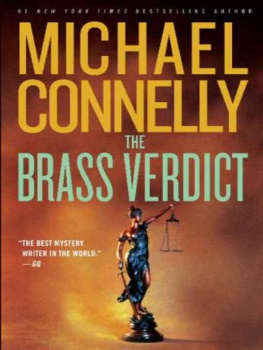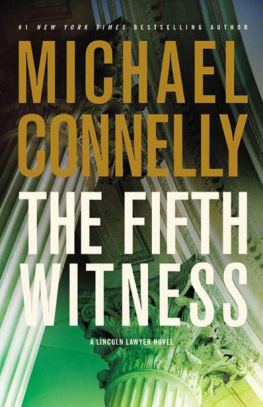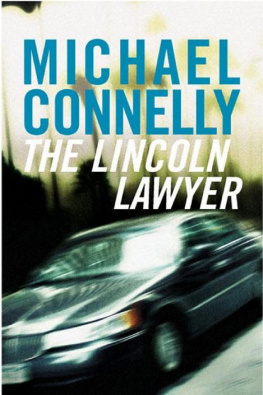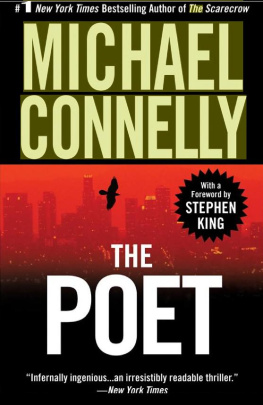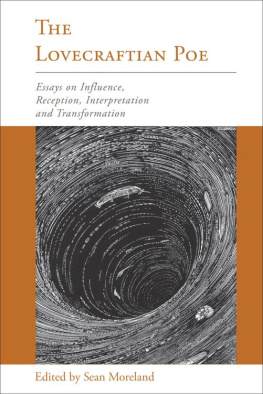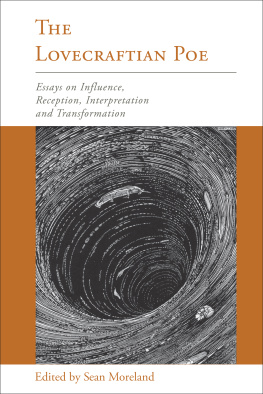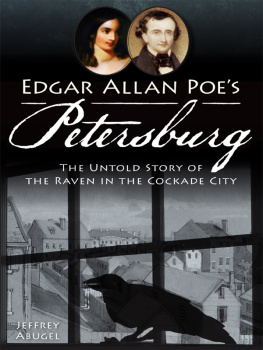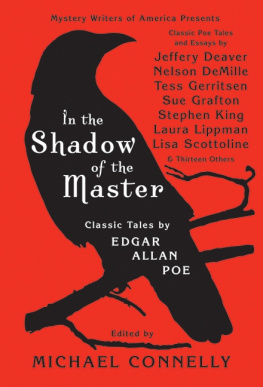
Michael Connelly, T. Jefferson Parker, Jan Burke, Lawrence Block, P. J. Parish, Lisa Scottoline, Laura Lippman, Laurie R. King, Tess Gerritsen, Stephen King, Steve Hamilton, Edward D. Hoch, Peter Robinson, S. J. Rozan, Neslon Demille, Sara Paretsky, Joseph Wambaugh, Thomas H. Cook, Jeffery Deaver, Sue Grafton
In The Shadow Of The Master: Classic Tales by Edgar Allan Poe
2009

Edgar Allan Poe (1809-49), while a mainstay of literature today and the recognized creator of the modern genres of horror and mystery fiction, spent much of his life chasing the public and literary acclaim he craved.
Born to David and Elizabeth Poe, young Edgar knew hardship from an early age. His father abandoned the family a year after Edgars birth, and his mother died of consumption one year later. Taken in, but never legally adopted, by John and Frances Allan, Edgar traveled with his new family to England in 1815, then continued on alone to study in Irvine, Scotland, for a short time. Afterward he studied in Chelsea, then a suburb of London until 1817. He returned to Virginia in 1820, and in 1826 he enrolled in the newly founded University of Virginia to study languages. During his college years, he became estranged from his foster father, claiming that John Allan didnt send him enough money to live on, but the reality was that Poe was losing the money on gambling.
In 1827 Edgar enlisted in the U.S. Army at age eighteen, claiming he was twenty-two years old. It was during this time that he began publishing his poems, including an early collection, Tamerlane and Other Poems, printed under the byline A Bostonian. He attained the rank of sergeant major of artillery and expressed a desire to attend West Point for officer training. Once accepted to the academy, however, he was dismissed for not attending classes and formations.
After the death of his brother, Henry, in 1831, Edgar decided to try making a living as an author. He was the first well-known American to make such an attempt, but because of the lack of an international copyright law and the economic effects of the Panic of 1837, he was often forced to ask for the monies owed him and compelled to seek other assistance. After winning a literary prize for his story Manuscript Found in a Bottle, he was hired as the assistant editor of the Southern Literary Messenger, but he was fired several weeks later for repeated drunkenness. This pattern of dissipation would haunt Poe for the rest of his life.
After marrying his cousin, Virginia Clemm, in 1835, Poe returned to the Messenger, where he worked for the next two years, seeing its circulation rise to 3,500 copies, from 700. His only fulllength novel, The Narrative of Arthur Gordon Pym of Nantucket, was published in 1838 to wide review and acclaim, although once again Poe received little profit from his work. The year after saw the publication of his first short story collection, Tales of the Grotesque and Arabesque, which received mixed reviews and sold poorly. He left the Messenger and worked at Burtons Gentlemans Magazine and Grahams Magazine before announcing that he would start his own literary publication, The Penn, later to be titled The Stylus. Tragically, it never came to print.
Virginia first showed signs of tuberculosis in 1842, and her gradual decline over the next five years caused Edgar to drink even more heavily. The one bright spot in this time was the publication in 1845 of one of his most famous works, The Raven, which brought him widespread acclaim; unfortunately, he was paid only nine dollars for the poem itself.
Shortly afterward, the Poes moved to a cottage in the Fordham section of the Bronx, New York, where Virginia died in 1847. Increasingly unstable, Edgar tried to secure a position in government, unsuccessfully courted the poet Sarah Helen Whitman, and eventually returned to Richmond, Virginia, to rekindle a relationship with Sarah Royster, a childhood sweetheart.
The circumstances surrounding Poes death remain shrouded in mystery. Found on the streets of Baltimore, Maryland, delirious and dressed in clothes that werent his, Poe was taken to Washington College Hospital, where he died on October 7, 1849. It was reported that his last words were Lord help my poor soul, but this cannot be proven as all records surrounding his death have been lost. Edgar Allan Poes death has been attributed to various causes, including delirium tremens, heart disease, epilepsy, or meningeal inflammation. He was buried in a Baltimore cemetery, where a mysterious figure has toasted Poe on the anniversary of his birth since 1949 by leaving cognac and three roses at his headstone.
Recognized primarily as a literary critic during his lifetime, Poes work became popular in Europe after his death owing mainly to the translations of his stories and poems by Charles Baudelaire. Sir Arthur Conan Doyle cited him as the creator of the mystery short story with his C. Auguste Dupin stories, saying, Where was the detective story until Poe breathed the breath of life into it? Poes work also inspired later authors of science fiction and fantasy, including Jules Verne and H. G. Wells. Today he is recognized as a literary master who both created new genres and reinvigorated old ones with a unique combination of story and style.
About the Mystery Writers of Americas Edgar Award
In 1945, when the Mystery Writers of America was just being formed, the founders of the organization decided to give an award for the best first American mystery novel, as well as awards for the best and worst mystery reviews of the year. Initially they were going to call it the Edmund Wilson Memorial Award (partly in revenge for Wilson s disdain for the genre), but calmer heads prevailed. Although it is unknown exactly who came up with the idea of naming the award for the Father of the Detective Story, it was an immediate success, and the Edgar was created.
The first Edgar Award was bestowed in 1946 on Julian Fast for his debut novel, Watchful at Night, and in the more than fifty years since, the stylized ceramic bust of the great author has become one of the top prizes in the field of mystery fiction. The award categories, in addition to Best First Novel, have been expanded over time to include Best Novel, Best Short Story, Best Paperback Original, Best Young Adult Novel, Best Juvenile Novel, Best Fact Crime, Best Critical/Biographical, Best Play, Best Television Episode, and Best Motion Picture. The Edgar has been won by many noted authors in the field, including Stuart Kaminsky, Michael Connelly, T. Jefferson Parker, Jan Burke, Lisa Scottoline, Laura Lippman, Laurie R. King, Steve Hamilton, Peter Robinson, Edward D. Hoch, S. J. Rozan, Thomas H. Cook, Joseph Wambaugh, Jeffery Deaver, Rupert Holmes, Anne Perry, Patricia Cornwell, Ira Levin, Thomas Harris, Dick Francis, Ruth Rendell, Lawrence Block, Elmore Leonard, Ken Follett, Frederick Forsyth, Harlan Ellison, and many, many others.
Harry Clarke (1889-1931) was a renowned stained-glass artist of the early twentieth century, and several examples of his work still exist today, most notably at the Honan Chapel in Cork, Ireland. It was during his education at Dublin Art School that he developed an interest in book illustration. After winning the gold medal in the stained-glass category at the 1910 Board of Education National Competition, he traveled to London to find work as an illustrator.
Next page


